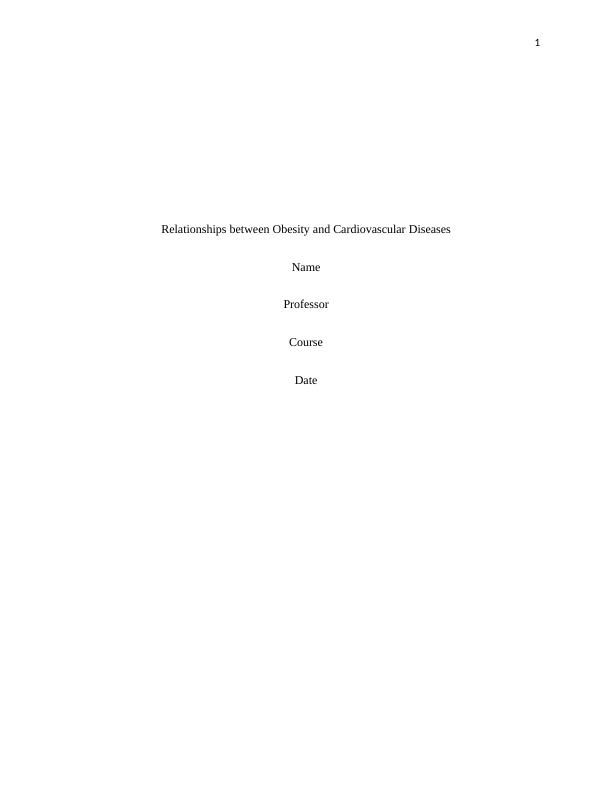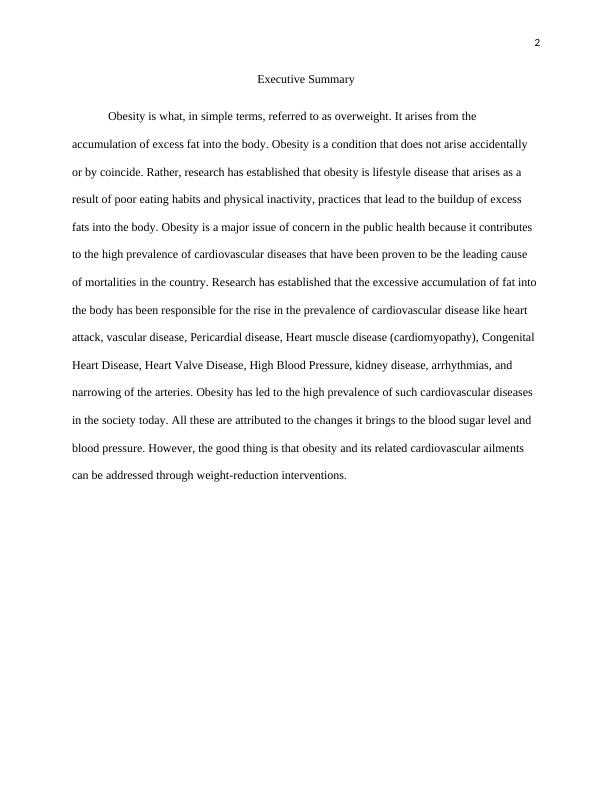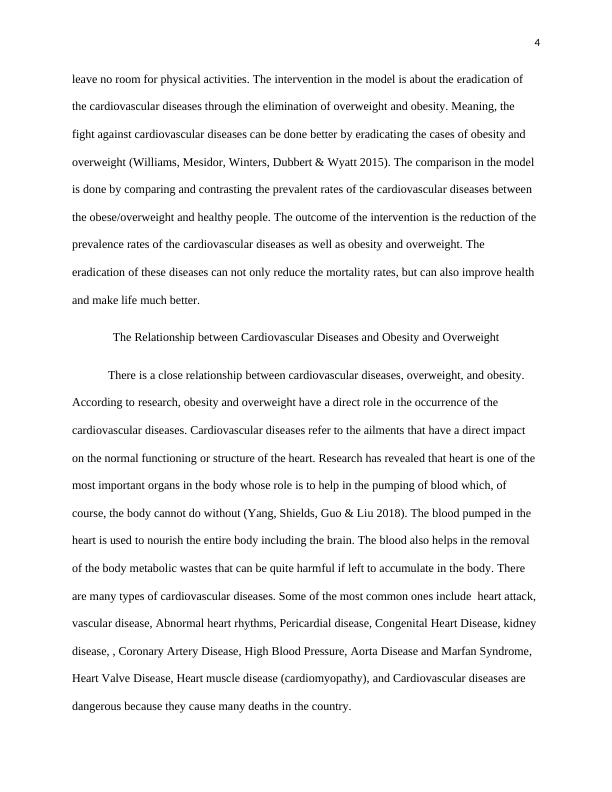Relationships between Obesity and Cardiovascular Diseases
Added on 2023-03-31
11 Pages2607 Words448 Views
1
Relationships between Obesity and Cardiovascular Diseases
Name
Professor
Course
Date
Relationships between Obesity and Cardiovascular Diseases
Name
Professor
Course
Date

2
Executive Summary
Obesity is what, in simple terms, referred to as overweight. It arises from the
accumulation of excess fat into the body. Obesity is a condition that does not arise accidentally
or by coincide. Rather, research has established that obesity is lifestyle disease that arises as a
result of poor eating habits and physical inactivity, practices that lead to the buildup of excess
fats into the body. Obesity is a major issue of concern in the public health because it contributes
to the high prevalence of cardiovascular diseases that have been proven to be the leading cause
of mortalities in the country. Research has established that the excessive accumulation of fat into
the body has been responsible for the rise in the prevalence of cardiovascular disease like heart
attack, vascular disease, Pericardial disease, Heart muscle disease (cardiomyopathy), Congenital
Heart Disease, Heart Valve Disease, High Blood Pressure, kidney disease, arrhythmias, and
narrowing of the arteries. Obesity has led to the high prevalence of such cardiovascular diseases
in the society today. All these are attributed to the changes it brings to the blood sugar level and
blood pressure. However, the good thing is that obesity and its related cardiovascular ailments
can be addressed through weight-reduction interventions.
Executive Summary
Obesity is what, in simple terms, referred to as overweight. It arises from the
accumulation of excess fat into the body. Obesity is a condition that does not arise accidentally
or by coincide. Rather, research has established that obesity is lifestyle disease that arises as a
result of poor eating habits and physical inactivity, practices that lead to the buildup of excess
fats into the body. Obesity is a major issue of concern in the public health because it contributes
to the high prevalence of cardiovascular diseases that have been proven to be the leading cause
of mortalities in the country. Research has established that the excessive accumulation of fat into
the body has been responsible for the rise in the prevalence of cardiovascular disease like heart
attack, vascular disease, Pericardial disease, Heart muscle disease (cardiomyopathy), Congenital
Heart Disease, Heart Valve Disease, High Blood Pressure, kidney disease, arrhythmias, and
narrowing of the arteries. Obesity has led to the high prevalence of such cardiovascular diseases
in the society today. All these are attributed to the changes it brings to the blood sugar level and
blood pressure. However, the good thing is that obesity and its related cardiovascular ailments
can be addressed through weight-reduction interventions.

3
Introduction
Obesity has become some of the most issues of concern to the public health sector.
According to the World Health Organization (WHO), obesity, that is simply called overweight,
is a condition in which an individual has a Body Mass Index (BMI) of 30 and above. Since the
normal BMI should be between 18.5 and 24.9, it means that anyone who has a BMI of between
25 and 29.9 is overweight. The major aim of this paper, therefore, is to give a critical and in-
depth study on the roles of obesity in the prevalence of cardiovascular diseases.
The Research Question
The research studies the roles of obesity on the prevalence of cardiovascular diseases in
the country today. Obesity has been classified as a dangerous lifestyle disease that is closely-
linked to a number of health issues especially the cardiovascular diseases. The research question,
hence, is: Why is the prevalence of the cardiovascular diseases higher amongst the obese and
overweight people than the healthy individuals. The development of this question was done
using the PICO model. PICO is an Evidence-Based Practice (EBP) model-an acronym that
denotes Problem/Population, Intervention, Comparison, and Outcome.
The problem that has been identified in the model is obesity, overweight, and the
cardiovascular disease. These are ailments that have been affecting people in the country for a
very long time. Obesity and overweight are lifestyle diseases that affect individuals as result of
the kind of lifestyle that they lead. This is mainly about the consumption of unhealthy sugar ad
calorie-rich food products as well as failure to engage in the physical exercises. This situation
has been brought about by the changing lifestyles that have compelled people to consume fast
and junk foods as well as use modern technologies and engage in numerous commitments that
Introduction
Obesity has become some of the most issues of concern to the public health sector.
According to the World Health Organization (WHO), obesity, that is simply called overweight,
is a condition in which an individual has a Body Mass Index (BMI) of 30 and above. Since the
normal BMI should be between 18.5 and 24.9, it means that anyone who has a BMI of between
25 and 29.9 is overweight. The major aim of this paper, therefore, is to give a critical and in-
depth study on the roles of obesity in the prevalence of cardiovascular diseases.
The Research Question
The research studies the roles of obesity on the prevalence of cardiovascular diseases in
the country today. Obesity has been classified as a dangerous lifestyle disease that is closely-
linked to a number of health issues especially the cardiovascular diseases. The research question,
hence, is: Why is the prevalence of the cardiovascular diseases higher amongst the obese and
overweight people than the healthy individuals. The development of this question was done
using the PICO model. PICO is an Evidence-Based Practice (EBP) model-an acronym that
denotes Problem/Population, Intervention, Comparison, and Outcome.
The problem that has been identified in the model is obesity, overweight, and the
cardiovascular disease. These are ailments that have been affecting people in the country for a
very long time. Obesity and overweight are lifestyle diseases that affect individuals as result of
the kind of lifestyle that they lead. This is mainly about the consumption of unhealthy sugar ad
calorie-rich food products as well as failure to engage in the physical exercises. This situation
has been brought about by the changing lifestyles that have compelled people to consume fast
and junk foods as well as use modern technologies and engage in numerous commitments that

4
leave no room for physical activities. The intervention in the model is about the eradication of
the cardiovascular diseases through the elimination of overweight and obesity. Meaning, the
fight against cardiovascular diseases can be done better by eradicating the cases of obesity and
overweight (Williams, Mesidor, Winters, Dubbert & Wyatt 2015). The comparison in the model
is done by comparing and contrasting the prevalent rates of the cardiovascular diseases between
the obese/overweight and healthy people. The outcome of the intervention is the reduction of the
prevalence rates of the cardiovascular diseases as well as obesity and overweight. The
eradication of these diseases can not only reduce the mortality rates, but can also improve health
and make life much better.
The Relationship between Cardiovascular Diseases and Obesity and Overweight
There is a close relationship between cardiovascular diseases, overweight, and obesity.
According to research, obesity and overweight have a direct role in the occurrence of the
cardiovascular diseases. Cardiovascular diseases refer to the ailments that have a direct impact
on the normal functioning or structure of the heart. Research has revealed that heart is one of the
most important organs in the body whose role is to help in the pumping of blood which, of
course, the body cannot do without (Yang, Shields, Guo & Liu 2018). The blood pumped in the
heart is used to nourish the entire body including the brain. The blood also helps in the removal
of the body metabolic wastes that can be quite harmful if left to accumulate in the body. There
are many types of cardiovascular diseases. Some of the most common ones include heart attack,
vascular disease, Abnormal heart rhythms, Pericardial disease, Congenital Heart Disease, kidney
disease, , Coronary Artery Disease, High Blood Pressure, Aorta Disease and Marfan Syndrome,
Heart Valve Disease, Heart muscle disease (cardiomyopathy), and Cardiovascular diseases are
dangerous because they cause many deaths in the country.
leave no room for physical activities. The intervention in the model is about the eradication of
the cardiovascular diseases through the elimination of overweight and obesity. Meaning, the
fight against cardiovascular diseases can be done better by eradicating the cases of obesity and
overweight (Williams, Mesidor, Winters, Dubbert & Wyatt 2015). The comparison in the model
is done by comparing and contrasting the prevalent rates of the cardiovascular diseases between
the obese/overweight and healthy people. The outcome of the intervention is the reduction of the
prevalence rates of the cardiovascular diseases as well as obesity and overweight. The
eradication of these diseases can not only reduce the mortality rates, but can also improve health
and make life much better.
The Relationship between Cardiovascular Diseases and Obesity and Overweight
There is a close relationship between cardiovascular diseases, overweight, and obesity.
According to research, obesity and overweight have a direct role in the occurrence of the
cardiovascular diseases. Cardiovascular diseases refer to the ailments that have a direct impact
on the normal functioning or structure of the heart. Research has revealed that heart is one of the
most important organs in the body whose role is to help in the pumping of blood which, of
course, the body cannot do without (Yang, Shields, Guo & Liu 2018). The blood pumped in the
heart is used to nourish the entire body including the brain. The blood also helps in the removal
of the body metabolic wastes that can be quite harmful if left to accumulate in the body. There
are many types of cardiovascular diseases. Some of the most common ones include heart attack,
vascular disease, Abnormal heart rhythms, Pericardial disease, Congenital Heart Disease, kidney
disease, , Coronary Artery Disease, High Blood Pressure, Aorta Disease and Marfan Syndrome,
Heart Valve Disease, Heart muscle disease (cardiomyopathy), and Cardiovascular diseases are
dangerous because they cause many deaths in the country.

End of preview
Want to access all the pages? Upload your documents or become a member.
Related Documents
Obesity-related Conditions and Heart Disease Risk in Australian Maleslg...
|11
|2798
|75
Obesity: Prevalence, Causes, Risk Factors and Interventionslg...
|7
|1827
|314
Childhood Obesity Report 2022lg...
|6
|1708
|17
Arguments for Taking a Public Health Approach to Obesitylg...
|7
|2453
|68
Risks of Maternal Obesity During Pregnancylg...
|6
|1034
|88
Causes, Symptoms, and Interventions for Obesitylg...
|8
|2037
|39